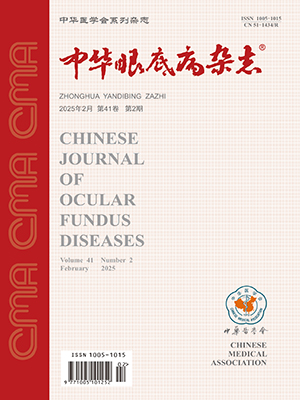| 1. |
Bandello F, Brancato R, Lattanzio R, et al. Relation between iridopathy and retinopathy in diabetes[J]. Br J Ophthalmol, 1994, 78(7): 542-545. DOI: 10.1136/bjo.78.7.542.
|
| 2. |
Rodrigues GB, Abe RY, Zangalli C, et al. Neovascular glaucoma: a review[J/OL]. Int J Retina Vitreous, 2016, 2: 26[2016-11-14]. https://pubmed.ncbi.nlm.nih.gov/27895936/. DOI: 10.1186/s40942-016-0051-x.
|
| 3. |
Osaadon P, Fagan XJ, Lifshitz T, et al. A review of anti-VEGF agents for proliferative diabetic retinopathy[J]. Eye (Lond), 2014, 28(5): 510-520. DOI: 10.1038/eye.2014.13.
|
| 4. |
Brancato R, Bandello F, Lattanzio R. Iris fluorescein angiography in clinical practice[J]. Surv Ophthalmol, 1997, 42(1): 41-70. DOI: 10.1016/s0039-6257(97)84042-8.
|
| 5. |
Bandello F, Brancato R, Lattanzio R, et al. Biomicroscopy versus fluorescein angiography of the iris in the detection of diabetic iridopathy[J]. Graefe's Arch Clin Exp Ophthalmol, 1993, 231(8): 444-448. DOI: 10.1007/bf02044229.
|
| 6. |
李士清, 王志立, 雷祥, 等. 增生型糖尿病视网膜病变患眼荧光素虹膜血管造影和荧光素眼底血管造影联合检查[J]. 中华眼底病杂志, 2015, 31(2): 179-180. DOI: 10.3760/cma.j.issn.1005-1015.2015.02.017.Li SQ, Wang ZL, Lei X, et al. Fundus fluorescein angiography combined with iris fluorescein angiography in patients with proliferative diabetic retinopathy[J]. Chin J Ocul Fundus Dis, 2015, 31(2): 179-180. DOI: 10.3760/cma.j.issn.1005-1015.2015.02.017.
|
| 7. |
李士清, 王志立, 李萍, 等. 荧光素虹膜血管造影联合眼底血管造影在DR合并新生血管性青光眼中的应用[J]. 中华实验眼科杂志, 2016, 34(12): 1112-1115. DOI: 10.3760/cma.j.issn.2095-0160.2016.12.013.Li SQ, Wang ZL, Li P, et al. Application of iris fluorescein angiography combined with fundus fluorescein angiography in diabetic retinopathy with neovascular glaucoma[J]. Chin J Exp Ophthalmol, 2016, 34(12): 1112-1115. DOI: 10.3760/cma.j.issn.2095-0160.2016.12.013.
|
| 8. |
李士清, 王志立, 李萍, 等. 虹膜荧光血管造影联合眼底荧光血管造影在全视网膜激光光凝术后糖尿病视网膜病变患者中的应用研究[J]. 眼科新进展, 2016, 36(2): 133-135. DOI: 10.13389/j.cnki.rao.2016.0036.Li SQ, Wang ZL, Li P, et al. Application of iris fluorescein angiography combined with fundus fluorescein angiography in proliferative diabetic retinopathy patients after panretinal photocoagulation[J]. Rec Adv Ophthalmol, 2016, 36(2): 133-135. DOI: 10.13389/j.cnki.rao.2016.0036.
|
| 9. |
Ferraz DA, Vasquez LM, Preti RC, et al. A randomized controlled trial of panretinal photocoagulation with and without intravitreal ranibizumab in treatment-naive eyes with non- high-risk proliferative diabetic retinopathy[J]. Retina, 2015, 35(2): 280-287. DOI: 10.1097/IAE.0000000000000363.
|
| 10. |
Sahyoun M, Azar G, Khoueir Z, et al. Long-term results of Ahmed glaucoma valve in association with intravitreal bevacizumab in neovascular glaucoma[J]. J Glaucoma, 2015, 24(5): 383-388. DOI: 10.1097/IJG.0000000000000234.
|




